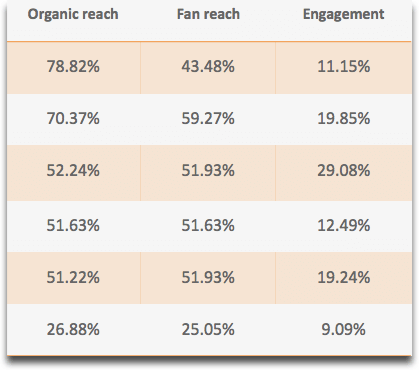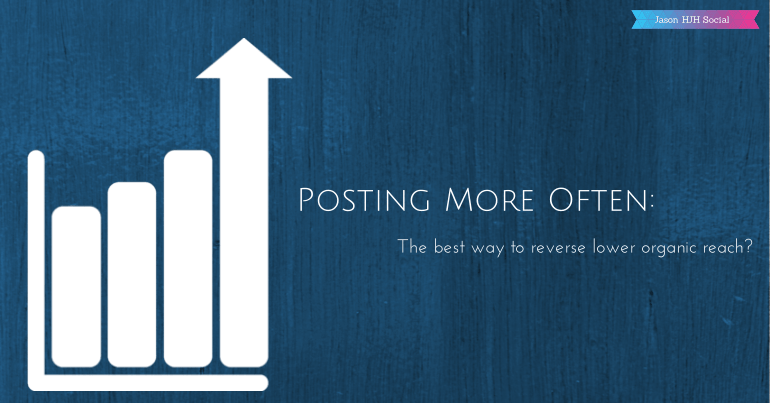The message from Facebook is clear: Pay to Play.
However, not all businesses have taken this message well. Some have left Facebook while others have tried creative methods to work around the lower organic reach.
Yes, average organic reach of a post has fallen. But the keyword here is average, which means that there will be exceptions. And I will share an example at the end of this post.
Before we get to that, I wanted to raise a point that Avtar, Marketing Manager at Circus Social, brought up saliently. You can read his article here (Trust me, this is worth your time).
Assumption: Reach is 2% instead of 16%, so posting 8 times will get you 16% (8 x 2%) reach.
One of the workarounds social media strategists have recommended is to post more often. At first sight, it makes sense. Since organic reach has fallen, to reach the same number of users, if not more, you have to post more often.
But Avtar argues that this is the very practice that got us to where we are in the first place - the average user receives far too many stories that can be published in their news feed at any one time.
So is posting more often really a practical solution? The crux of this problem lies in thinking about your social media goal: “are you trying to reach as many people as possible?” I don’t think so.
Actually, posting more often does not mean that you reach more people. The reason is post reach is calculated independently. Let’s take an example:
- Suppose your Page has 1000 fans and you post 3 times a day.
- Based on an average organic reach of 2%, each of your post reaches 20 unique users.
- Using this figure, you might think that you will reach 60 people a day. (20 x 3)
Will you? Nope. Because post reach count is independent of one another, it means that the same person can see 2 or 3 of your posts but still count as one person in each of your post reach metric.
If Jason sees Posts #1 and #2, your reach for post #1 will count him as 1, and your reach for post #2 will count him as 1. In total, he counts as 2 reach although you have only reached one person.
Of course, if you are looking at the Page-level reach, that is a different story. But the Page-level export does not show you the daily post fan-only reach. If this is not a concern for you, then you can use the figure found in column AG.
Now let’s return to our earlier discussion about your social media goal. Avtar suggested that businesses should put a bit of money behind every post you make, instead of posting more often. While I don’t think that these 2 options are mutually exclusive, I do agree that the latter option is better both in the short and long-term.
Here’s why:
1. You avoid the risk of irritating your fans
Yes, fans might like your brand. The fact that they ‘like’-ed your page means that they opted in to see your post. But are you sure that they want to see your posts multiple times a day? Even lovers need a break from one another, let alone a fan who only likes, not loves, your brand.
2. You increase the number of different fans who actually see your post.
The keyword here is different fans. This gives more of your fans, particularly those who lacked recent interaction with your Page, a chance to engage with your brand, creating a valuable touchpoint. In layman terms, if they click, like, comment, or share your post, it signals to Facebook that they enjoy your content.
What will Facebook do in return? They will show your Page content to these fans organically the next time you post something.
3. You put less stress on your Page Manager.
Think about it. To post 2-3 times a day means that your Page Manager needs to create 60-90 posts a month!
Ask any professional editor, copywriter, or PR professional and you will understand the difficulties behind writing a good piece of content/copy that drives engagement and captures reader interest from the beginning to the end. Let alone excellent pieces of content that actually drive sales. Even if you adopt a 80-20 ratio, they can hardly put together enough unoriginal content (or in our terms, curation) that value-add to your fans.
Productivity of your Page Manager is not measured by how many posts he makes, but how the posts perform over time and show effects in your social media KPIs.
I hope that you understand where I am coming from. I strongly believe in 3 things:
- We can adopt best practices if and only if they align with your social media goals. Unless your goal is to increase post reach, which is hardly ever the case, you should consider putting a bit of money behind every post
- Apart from the previous consideration, also consider whether this advice is sound for your business’ context. Don’t simply take it from me and do it for your business. You need to understand (I mean it) how adopting this practice will impact your business, both negatively and positively
- There is nothing wrong to pay and promote your post. Why? Ultimately, your business should make money from your social media efforts, and promoting your post should lead indirectly to an increase in KPI. If your business does not, then it’s not the fault of Facebook to ask you to pay, but your fault in not developing a proper strategy framework or thinking about your goals on social media
So here’s an example of an exception: a client’s Facebook Page (of over 1000 fans) that has not spent a single cent on Facebook Ads, which doesn’t post often, yet achieved high organic reach consistently and even generated multiple leads.

Each row of the table above reflects the results of each post. As you can see, organic fan reach hovers around 40 - 50% most of the time,while engagement is hardly ever below 10%. The Page has only posted 6 times in the last 30 days - far below the Page “best posting practice” of 3 times a day.
This is what we learned:
One Size Fits Nobody
While a lot of those tips going around online are great and sometimes fresh, it comes down to the individual brand’s social media team to decide which practices to adopt. Plus, you may need to tweak the practice slightly to make it work for your brand.
For us, we recognised that we were not a lifestyle brand. Our engagement strategy was not to post something and interact with our fans everyday. That works for Oreo, but not for everyone.
But our engagement strategy still stresses consistency. We came up with a list of things that we could post on the Facebook Page. If something new came along, we would decide whether the post value-adds to our fans, and in turn, to our efforts. Consistency was therefore exercised in our choice of content, aligning closely with our goal.
As you might have realised, you cannot consider your posting frequency in isolation. It should be informed by your strategy, and considered side by side with other elements, such as your choice of content. While Facebook may throw the newsfeed algorithm into chaos again, one thing never changes: quality content will always triumph quantity.
Your clients’ or company’s resource constraints also matter - it might be impossible for you to put money behind each post. Even so, like the example above has illustrated, you may not want to rush into increasing your post frequency to make up for the drop in organic reach. It is just not simple as 1+1=2.
Comments?



Pingback: Posting more often: Is that really the best way...
Pingback: Why is Facebook ‘engagement’ important? | ThinkMoveGo